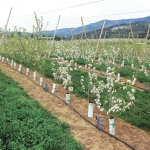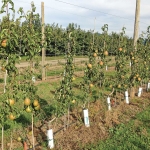An Oregon State University researcher is testing pear rootstocks that might have the potential to improve early bearing of pear trees, control tree vigor, and enhance production of high-quality fruit in the Pacific Northwest.
There is not currently a dwarfing, precocious rootstock available for pears as there is for apples. Old Home by Farmingdale 87, the industry standard, reduces pear scion vigor by 30 percent compared to a seedling rootstock.
The industry would like to have a rootstock that is about 50 percent the size of a seedling rootstock and is more precocious, particularly for d’Anjou, which takes a long time to come into production.
Commercially available dwarfing quince rootstocks, which are commonly used for pears in Europe, are reputed to not be hardy enough for the Pacific Northwest. A multi-year evaluation of the freeze resistance of these selections confirmed this suspicion.
Dr. Todd Einhorn, horticulturist at the Mid-Columbia Agricultural Research and Extension Center (MCAREC) in Hood River, says some quince selections, however, are hardy, but other issues associated with quince—such as graft incompatibility, iron chlorosis, pear decline, and fire blight susceptibility—have not been evaluated for these selections.
Einhorn obtained a large number of quince accessions from the National Clonal Germplasm Repository at Corvallis, Oregon, and tested them for cold hardiness. He found 22 quince selections that were as hardy or hardier than the commonly used rootstocks OHxF 87 or OHxF 97 and could withstand temperatures down to -22°F (-30°C).
In 2016, he will put the top ten of the quinces from his tests into a trial in Wenatchee and Hood River, with and without interstems and with Bartlett and d’Anjou as the scions. The trees are being produced in the nursery now.
In addition, Einhorn is evaluating Quince Eline, a purported cold-hardy quince rootstock, which is being propagated in The Netherlands and appears to be hardy down to -12°F. Compared with OHxF 87, it looks good, he said, but it is not as productive as Amelanchier
(serviceberry) which he is also testing as a pear rootstock.
Amelanchier
Amelanchier, which is native to North America, is a very cold-hardy plant that grows well in Canada. It can withstand a -40°F temperature in mid-winter with little to no browning of the wood. Dr. Michael Neumüller, breeder at the Bavarian Center for Fruit Crops in Germany, has developed Amelanchier rootstocks, which are compatible with Beurre Hardy and Comice. Compatibility with other pear varieties is not yet known.
In a trial in Oregon with d’Anjou, trees on the Amelanchier rootstocks were half the height of those on OHxF 87 and produced 20 pears per tree (14 bins per acre) last season in the third leaf, and the fruit was large (box size 70), Einhorn reported. “To me, that’s remarkable.”
The trees on Amelanchier did not have much extension growth and were loaded with fruit buds. The leaf-to-fruit ratio was 40:1. The number of leaves per tree, interestingly, was equivalent to trees on OHxF 87, but those trees had no fruit.
Horner
Einhorn, in collaboration with Tom Auvil, research associate with the Washington Tree Fruit Research Commission, also oversees on-farm trials with the Horner rootstocks, which were developed more than 30 years ago by Oregon nurseryman David Horner from open-pollinated Old Home by Farmingdale material.
Initial trials indicated that two selections, Horner 4 and Horner 10, produced good yields and fruit size, compared with OHxF 97. Horner 4 seemed precocious, even though it produced a large tree.
In a recent orchard trial in Wapato, Washington, with Bartlett planted at 1,089 trees per acre (4-by-10 feet), OHxF 87 produced 55 bins per acre in the fifth leaf, compared with 48 bins for Horner 4 and 44 bins for Horner 10, but fruit from the Horner 10 trees was smaller than fruit on trees on the other two rootstocks.
OHxF 87 in a mirror trial with Golden Russet Bosc produced 43 bins per acre compared to 33 bins per acre for Horner 4 and Horner 10. Fruit size of Bosc was largest for Horner 4.
In an orchard trial in Oregon with d’Anjou, with 427 trees per acre, trees on Horner 4 were 50 percent larger than those on OHxF 87 or Horner 10. OHxF 87 produced 42 bins per acre (107 pears per tree) in the sixth leaf, compared with 42 bins for Horner 4 and 29 bins for Horner 10. Einhorn said the grower has not been deterred by the vigorous Horner 4. In fact for d’Anjou, Horner 4 might be a good fit for sites with low vigor or replant situations.
Tired trees
A ten-year rootstock trial with d’Anjou and Bosc pears that Einhorn ran in collaboration with Tim Smith, Washington State University Extension specialist, showed that of the OHxF rootstocks, OHxF 87 was the best in terms of production and fruit size. But some growers have reported that, after about 10 years, Bartletts on OHxF 87 start to become tired and weak.
Einhorn said in a 15-year-old planting at MCAREC of Bartlett on OHxF 87 and 97 rootstocks, he did not find that to be the case and OHxF 87 outyielded 97. However, with Red d’Anjou as the scion, OHxF 87 can produce a weak tree and not perform so well. With this variety on OHxF 87, closer tree spacing, some fruit thinning, and vigor promotion might be advisable, he said.
New trial
In 2013, Einhorn began a rootstock and systems trial with d’Anjou as the scion. He is comparing OHxF 87, OHxF 69, and the German rootstock Pyro-233. The trees are trained to three systems: steep upright V with trees leaning in alternate directions; a bi-axis system, with trees double budded in the nursery; and single axis. In-row tree spacings are 3 feet, 4.5 feet, or 6 feet, with 12 feet between the rows.
After two seasons, trees on Pyro-233 had smaller trunks than trees on other rootstocks. Individual axes of bi-axis trees, where the vigor is spread over the two axes, were half the size of single axis trees trained to other systems and had more flowers. Einhorn expects that as the trees grow, those planted with the closest in-row spacing will be more dwarfed because of inter-tree competition. •








I look forward to an Enhorne update
Agreed. It would be nice to know current stats.
Hello, here are two of our recent stories on pear rootstock trials:
— https://www.goodfruit.com/rooting-out-solutions-for-pear-growers/
— https://www.goodfruit.com/quince-comparisons/
Hi Richard
Hi Jonelle
I may have some new pear dwarfs started from seed possibly crossed between two Depot Trees or catalog maybe @ Kieffer and one dwarf labeled ‘Asian Pear’ that turned out a really great Bartlett type making an extra large fruit but unfortunately I did not get fruits on this dwarf for maybe 20 years until the flowering, I believe, was skewed by the Uri storm… I ended up with 4 fruits and one seedling . It has tried one other time the size of the tree is maybe 1/3 of Kieffer but perhaps due to rootstock though I can just tell it’s a smaller sized type of tree
I planted seeds from the Kieffer closeby and another Kieffer a little further away assuming they may have crossed and i got some surprises. I did get mostly smaller trees with smaller Bartlett type leaves from the tree closest and the other batch had a few that grew much taller with alot of variation from both batches .. the smallest only having grown about 3 inches in its first year… many at less than 1 foot and just a handful approaching 2 feet in the first year
Both the dwarf and the Kieffer show excellent tolerance to Rust and Blight, they each had both years ago, still rust in the area from junipers.. they outgrew the issues with minimal help.. some of the seedlings have rust dots now and so far they appear to be outgrowing while maybe 1/3 or more don’t show any signs (without looking too close). No issues with heat either…
I strongly believe these crossed but there is the possibility that a neighbors ornamental pear played a role though the closer tree to the dwarf made lead shape that seems to match and generally smaller trees.. the Kieffer pears I’ll add make incredibly sweet fruits when ripened properly but unfortunately they are only good for a few days at that point when refrigerated but just the fact that the tree make spurs and fruits at every spur every year.. makes it a winner
one year the two, Kieffer and the Dwarf had blight obviously… I freaked and just trimmed off the blight, it came back minimally over the next couple of years… I did nothing and haven’t seen much since its been some years …
I suspect the dwarf may be on the worst OxF stock which is known for influencing the fruiting habits negatively but also the tree gets alot of shade and the flowers always seem to wait until right after Kieffer drops the last flowers so I have put in a polllinator ‘Moonglow’ and also grafted some Maxine branches
Nearby… the tree did flower again last year but only set two fruits that barely developed before squirrels snatched them.. my main goal is the same or similar fruit in abundance and I’m not sure if the tree would set more in a full sun position it is completley shaded the first half of the day by a large Mulberry …crown is maybe 8-10 feet wide and as tall with me only having removed the main leaders over the years (I suspect now that its like an apple that would fruit more with pruning since is flowers at the ends of branches)
The fruits from the dwarf reminded me of large Bartletts I got from a local grocery store labeled Bartlett, Argentina which had exceptional flavor and size maybe double the average Bartlett size… another I’m reminded of was labeled ‘Bijou’ which I would guess Is a Bartlett x D’Anjou cross they were the most perfect pear I have eaten, Bartlett Flavor and unforgettable sweetness / texture I haven’t seen the same at stores again
Anyhow I’m sitting on a few crates worth of baby pears and maybe some are candidates for a rootstock trial I would need more land to play with this some more .. Maybe someone would want to work a business deal and to share some tips so that I’ll know what I should try next! If anything I will probably test them in a few year with my own trial and make a little field of the heaviest fruiters If I’m lucky
Feel free to share my email address with anyone interested and we can discuss further or contact me for necessary permissions.
Oops I made a mistake my tallest is 15 inches they just seemed BIG to me. Many at around six Inches and in between that and one foot and several below six inches. Three out of 60+ seedlings at around or just over a foot plus the one at 15 inches. My smallest is less than 2 inches actually so maybe a Super-Dwarf, time will tell :)
The tallest btw just happened to turn red a month or so earlier than all of the others. I suspect the Ornamental cross but the leaf shape is very Kieffer like… the 4 big ones all have regular Kieffer-like leaves with the rest showing varying shapes some round, some pointed like a spade, bigger smaller etc…